This is a dual debate about 1) whether to mend worn places in vintage quilts and 2) whether to keep on using them.
I have this theory about old things: In general, they like to be used. I’m not talking about priceless museum pieces or antique art objects, of course. But that vintage potato masher in the kitchen drawer? Still makes the best mashed potatoes ever. And great-aunt Julia’s ironing board? Heavy as sin, but oh-so-sturdy.
I feel the same way about vintage textiles, specifically two quilts made by long-gone members of my family. These are not great works of q-art, but they’re part of our family’s textile story. They’ve been well loved and well used. One is this lap quilt made by my great-aunt Joanna. It’s a simple Four (or is it Nine?) Patch, probably about 40 years old, with a right-angled tear in one square.
I used it a lot during college and early job years, but lately, it had been resting in a trunk. I recently brought it out of retirement to splash some color on the back of the sofa. (Would you believe the colors are pretty fresh and on trend by today’s palette standards? Bonus!)
The second vintage quilt is a hand-pieced, bed-sized tied comforter in a Tumbling Blocks variation using lots of feed sack fabrics. (A portion is shown at the top of this post. It’s dang big and there were no handy giants hanging out to help with a full shot.) I estimate its age to be closer to 80 years, and I’m told that my grandmother Lucille and great-grandmother Zola both had a hand in making it. Some of my mom’s baby dresses gave up scraps for this quilt, and it’s gotten used, too. It’s the perfect summer-weight topper and a favorite for napping. Both of our girls curled up under this one regularly and well, I just took a nap under it myself earlier today. (Just a short one. Don’t tell.) Stitching on several segments has unraveled and parts of some blocks have come loose from their seams. One fabric in particular is just shredding from age.
Okay, so you don’t think I am a complete quilt idiot, let me just brag about the hand-pieced quilt—vintage Dresden plate blocks with hand embroidery and hand quilting—hanging on an inside wall in my house. From a fabric sleeve on the back. Away from windows. And yes, it gets to rest now and then.
I bet I’m not the only Q-Bie with a quandary like this, though. A lot of us have probably inherited quilts from our needleworking forebears that we would like to carefully use, and that may need a bit of mending.
Which brings me to my dual debate: Should I keep using these? Should I mend them?
Quilt conservation expert Ann Wasserman would probably say “No,” and “It depends.” Ann has 30 years experience in quilt care and restoration, but she is also an art quilter, a professional costumer and lectures on quilt and textile conservation. Oh, and she’s got a B.A. in anthropology, which gives a lot of credibility to her views on quilts being historical records.
Her site has some excellent advice about deciding whether to mend an antique or vintage quilt, and how you go about doing it, if that’s your choice. And you can read about some of her current conservation and repair projects on her blog.
She has a thought-provoking discussion about how to evaluate quilts in need of repair according to their historical and sentimental value, your plans for use and what’s really important to you. She’s even developed an equation for considering this whole tangle.
Here’s what I learned from Ann’s site:
- Restoration always lessens the historical value of a quilt.
- Restoration, aka repair, is different from conservation. The former means fixing; the latter means stabilizing.
- By definition, “repair” may make a quilt useful again…
- BUT putting a quilt back into action that has already damaged it will just mean the wearing-out process will continue. (And then you just won’t have a quilt at all, will you?)
Suddenly, I feel as if I’ve been committing fabri-cide.
Will I repair my ailing vintage quilts? Will I keep using them?
Well, in true cliff-hanging spirit (like all the season finales we’re seeing on TV lately), I’m not gonna answer that. Yet. Tune in a few days from now, for more on this subject.

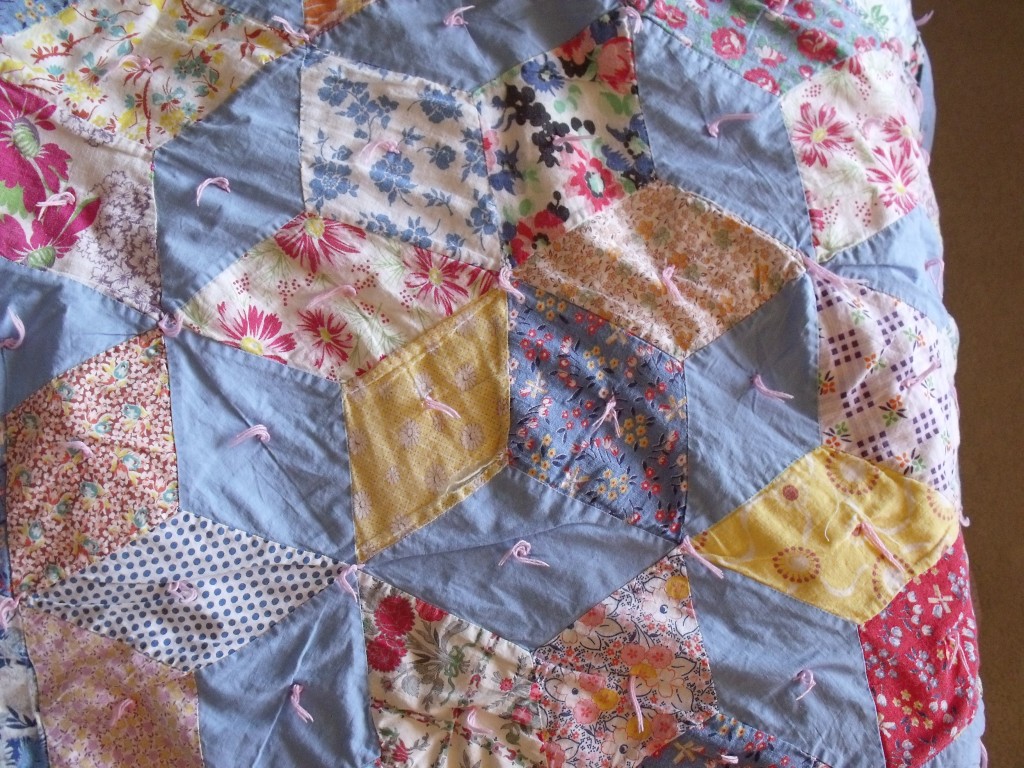
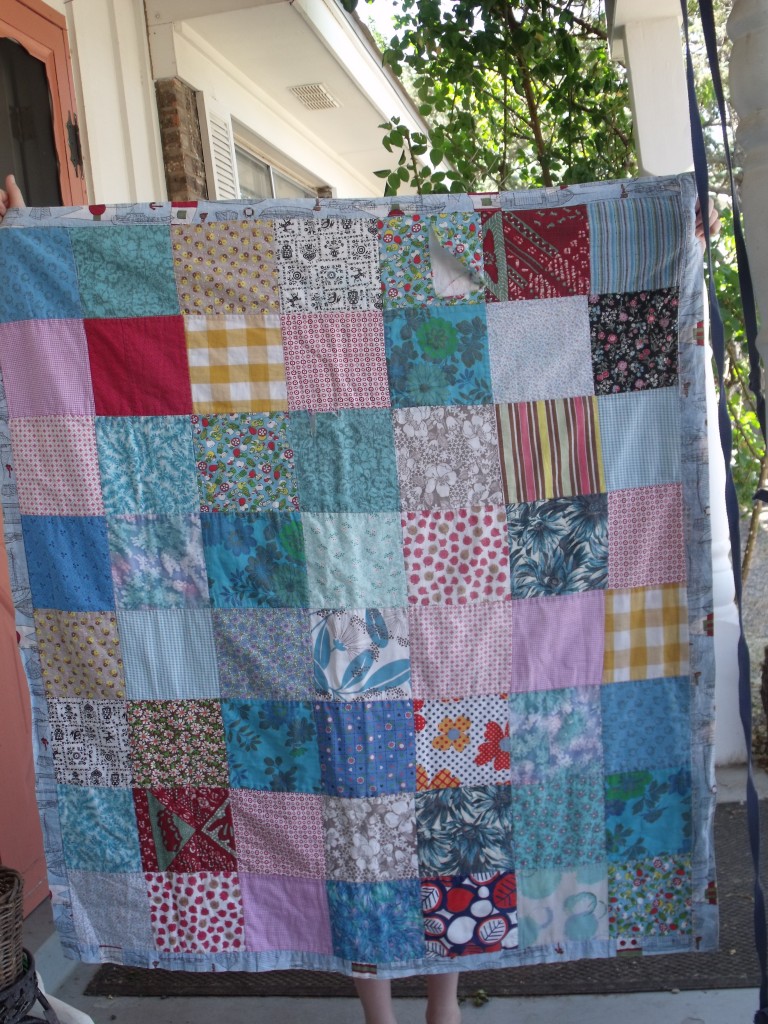
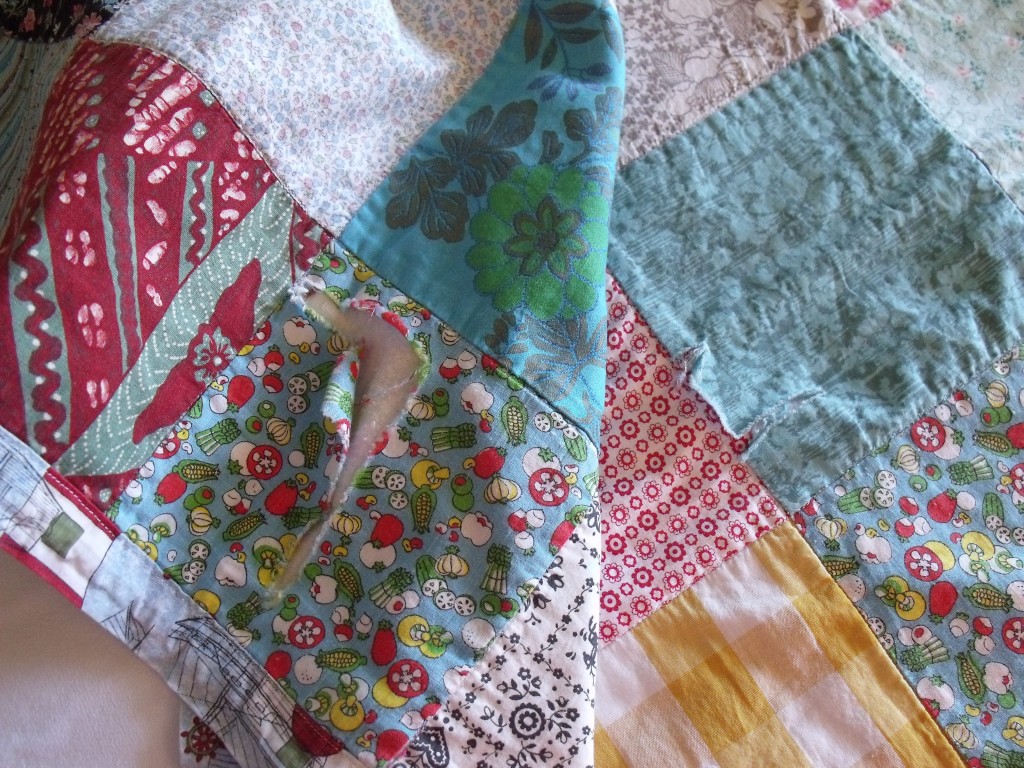
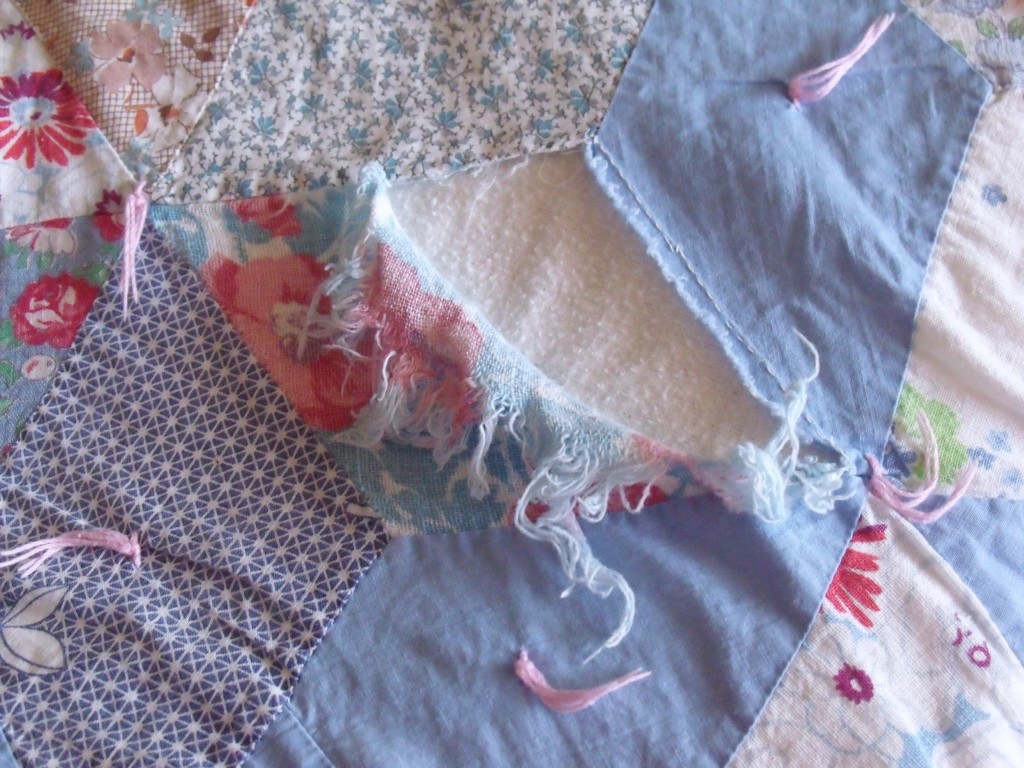





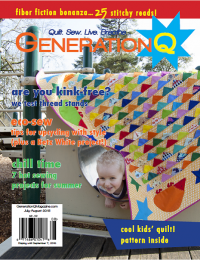
COMMENT #1
Just my opinion, but I would say those are utility quilts: meant to be used! They don’t have huge historical value, except as a family memory. I would fix them and keep using them and enjoying them as you obviously do!
COMMENT #2
I have one of those from the ex husbands great grandmother. I’ve actually considered taking some of the larger pieces and making something from it. Or putting it in a shadow box. That way both kids could have some of it. I tell myself its better than having it live in a chest where it never gets seen.But it also seems sacreligious!
COMMENT #3
What is “historical value”? You aren’t planning to sell the quilts that you use and love….and mending them makes you part of the historical chain that runs through them. I’d say repair the damage and continue to enjoy the love that those ladies poured into them.
COMMENT #4
I’m along the same lines of repair and enjoy. I have a few odd quilts and quilt tops I have picked up at yard sales and thrift stores. The intention was to use them to make things, maybe even a sundress. Enjoy those made by your family. Use them and repair them I say. What ever pieces of them are left when your kids inherit them will still make them happy, and they will remember what a treasure they are because you have told them about your relatives making them. I think tangible objects make long lost relatives seem more real to our children too. 🙂 Thought provoking write up, thanks for sharing!
COMMENT #5
There arent many quilts that are going to have important historical value or monitary value. And most that have survived are already in museums. If you have the type of family that cares about your history, then do whats needed to keep them from falling apart further. Like not tossing in the washer. But fabric isnt something that lasts very long in the antique scheme… Id repair them and use gently, letting the next generation create memories and attachment to them as you have. Really, things only have value based on our emotional feeling about them. And no one will care if they are in a closet without being seen and having the stories told about them.
COMMENT #
Just don’t let the dogs anywhere near them!
COMMENT #6
An unused quilt is a sad quilt! I’m sure the wonderful ladies who made those quilts intended them to be used, not stored for historical value! Repair them and allow your children and grandchildren to store up wonderful memories with them!!
COMMENT #7
Your vintage quilts are so lovely; what comforting treasures! I think I would mend the younger one and use it as you have been. For the older one, I would also mend it, but use it a little more carefully, like as a cover on the guest bedroom bed, or some other non-daily use. I loved using the old quilts at my grandma’s house when I was young. I would daydream of the wonderful women who had worked so hard for their families.
You post reminded me of an old quilt I have in a box somewhere. It also needs some mending, and I’m going to dig it out and bring it back to life. Thanks!
COMMENT #8
I adhere to the “it depends” mindset. Some quilts should be put away or hung, but some are just made to give fabric hugs to generations to come. If you want to use them, repair them! Think of how pleased your grandmother and great aunt would be to know you are wrapping your family in their loving stitches, even today. I have one that my great-grandmother and her sister made, and it is quite clear that when it got worn, they reinforced it with bigger stitches so that it could continue to be used. I like the idea someone mentioned here of reusing parts of vintage quilts; I know someone who cuts up the better parts to make sewing satchels. In the end, we have to discern how to derive the most joy from those old quilts. Good luck finding your answer! 🙂
COMMENT #9
I would fix ’em & use ’em myself. Isn’t that why they were made in the first place, to be used?
COMMENT #10
Many thanks, Melissa, for visiting my website and writing about it! I will add to everyone’s thought process: I always recommend to people with family quilts to write down the history of the quilt and quiltmaker – the maker’s name, where she was living and what her life was like at the time she made the quilt, how it came to you, etc. All this information makes it much more special as a family heirloom, and also can be really great if a local historical society is interested in local quilts. Another section describing the repair work you have done, including swatches of any fabrics you have added as patches, will help future owners figure out what’s what. You can keep the information, maybe with a photo of the quilt attached, with your other important papers.